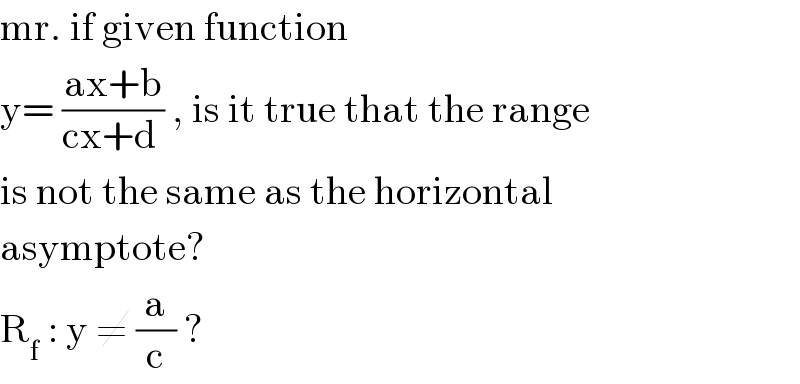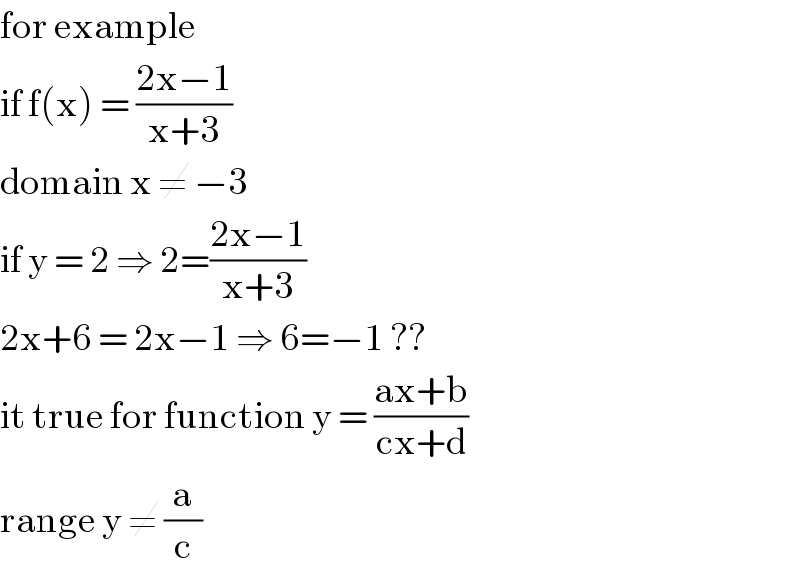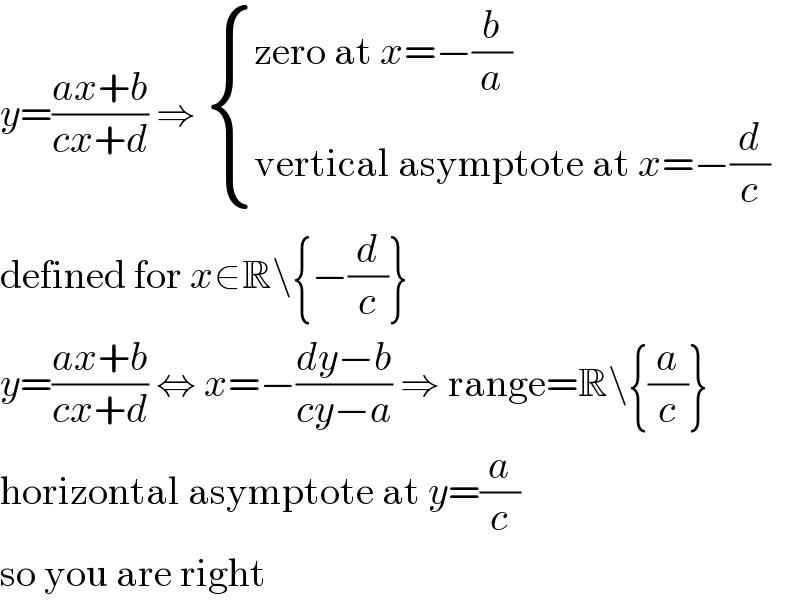
Question and Answers Forum
Question Number 79883 by MJS last updated on 29/Jan/20
![to Sir Jagoll (and of course everybody else) (1) y=((x^2 −x−6)/(x^2 −3x−4))= =(((x−3)(x+2))/((x−4)(x+1))) ⇒ ⇒ { ((zeros at x=−2; x=3)),((vertical asymptotes at x=−1; x=4)) :} defined for x∈R\{−1; 4} range: transforming y=((x^2 −x−6)/(x^2 −3x−4)) to x^2 −((3y−1)/(y−1))x−((2(2y−3))/(y−1))=0 D=((25y^2 −46y+25)/(4(y−1)^2 ))>0∀x∈R ⇒ ⇒ { ((range=R)),((horizontal asymptote at y=1 (∗))) :} (∗) doesn′t mean y=1 is not within range!!! x=1 ⇒ y=1 y′=−((2(x^2 −2x+7))/((x−4)^2 (x+1)^2 )) no real zeros ⇒ ⇒ no local extremes y′′=((4(x^3 −3x^2 +21x−25))/((x−4)^3 (x+1)^3 ))=0 at x≈1.33131 ⇒ ⇒ turning point (2) y=((x^2 −x−6)/(x^2 −3x+4))= =(((x−3)(x+2))/(x^2 −3x+4)); x^2 −3x+4=0 no real zeros ⇒ ⇒ { ((zeros at x=−2; x=3)),((no vertical asymptote)) :} defined for x∈R range: transforming y=((x^2 −x−6)/(x^2 −3x+4)) to x^2 −((3y−1)/(y−1))x+((2(2y+3))/(y−1))=0 D=−((7y^2 +14y−25)/(4(y−1)^2 ))≥0 for −1−((4(√(14)))/7)≤y≤−1+((4(√(14)))/7) ⇒ ⇒ { ((range=[−1−((4(√(14)))/7); −1+((4(√(14)))/7)])),((horizontal asymptote at y=1 (∗))) :} (∗) doesn′t mean y=1 is not within range!!! x=5 ⇒ y=1 y′=−((2(x^2 −10x+11))/((x^2 −3x+4)^2 ))=0 at x=5±(√(14)) y^(′′) =((4(x^3 −15x^2 +33x−13))/((x^2 −3x+4)^3 )) y′′ { ((>0 at x=5−(√(14)) ⇒ local minimum)),((<0 at x=5+(√(14)) ⇒ local maximum)),((=0 at { ((x≈.506699)),((x≈2.06421)),((x≈12.4291)) :} ⇒ 3 turning points )) :} (3) y=((x^2 −x+6)/(x^2 −3x−4))= =((x^2 −x+6)/((x−4)(x+1))) ⇒ ⇒ { ((no real zeros)),((vertical asymptotes at x=−1; x=4)) :} defined for x∈R\{−1; 4} range: transforming y=((x^2 −x+6)/(x^2 −3x−4)) to x^2 −((3y−1)/(y−1))x−((2(2y+3))/(y−1))=0 D=((25y^2 +2y−23)/(4(y−1)^2 ))<0 for −1<y<((23)/(25)) ⇒ ⇒ { ((range=R\]−1; ((23)/(25))[)),((horizontal asymptote at y=1 (∗))) :} (∗) doesn′t mean y=1 is not within range!!! x=−5 ⇒ y=1 y′=−((2(x^2 +10x−11))/((x−4)^2 (x+1)^2 ))=0 at x=−11; x=1 y′′=((4(x^3 +15x^2 −33x+53))/((x−4)^3 (x+1)^3 )) y′′ { ((>0 at x=−11 ⇒ local minimum)),((<0 at x=1 ⇒ local maximum)),((=0 at x≈−17.1098 ⇒ turning point)) :}](Q79883.png)
Commented by TawaTawa last updated on 29/Jan/20

Commented by jagoll last updated on 29/Jan/20

Commented by jagoll last updated on 29/Jan/20

Commented by john santu last updated on 29/Jan/20

Commented by jagoll last updated on 29/Jan/20

Commented by MJS last updated on 29/Jan/20

Commented by jagoll last updated on 29/Jan/20
![sir your notation is ]14−4(√(6 )) ; 14+4(√6) [ it same as y ≤ 14−4(√6) ∨y ≥ 14+4(√6) ?](Q79898.png)
Commented by MJS last updated on 29/Jan/20
![depends... y∈[a; b] is the same as a≤y≤b ⇒ y∈R\[a; b] means y<a∨y>b y∈]a; b[ is the same as a<y<b ⇒ y∈R\]a; b[ means y≤a∨y≥b](Q79899.png)
Commented by jagoll last updated on 29/Jan/20

